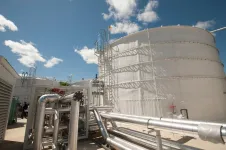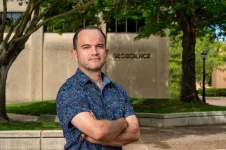(Press-News.org) As California works to meet climate and air quality goals, a key to the transition will come from biomass, which is renewable organic material from plants and animals.
New research from the University of California, Davis, published in the journal Global Change Biology Bioenergy, examines the good and bad uses of biomass and the best pathways to meet California’s goal of reducing carbon dioxide emissions by 85% of 1990 levels by 2045.
“California is fortunate in having a large biomass resource,” said lead author Peter Freer-Smith, an adjunct professor in the Department of Plant Sciences. “Finding the best use of biomass remains challenging, and this study outlines future scenarios for effective use.”
Not all biomass is equal
California’s biomass resources are vast and widespread across the state, with as much as 54 million dry tons available each year. This comes mostly from forests and wildlands, municipal solid waste, animal manure and crop residues such as material left over from harvest.
But use of this biomass is controversial, and not all biomass is equal. Using this resource effectively to produce energy, as well as minimize greenhouse gas emissions and air pollution is key to a sustainable future for California.
Policymakers, planners and others working to reduce waste streams and pollutants should use the study as a resource, said Freer-Smith.
“Using this information, we can take action to ensure that biomass is used effectively in California,” he said. “If you’ve got a bad use, then you can use biomass in a different way, or you can change the technology so that you address the problems associated with that use. Also, some biomass is waste, so we have to get rid of it, and we might as well do something sensible with it.”
Freer-Smith and other researchers examined more than 400 papers written from 2005 to 2022 about biomass use in California and cataloged the effects on emissions.
Choosing the right path for biomass
The paper finds that there are 34 pathways that either help reduce greenhouse gases or specific air pollutants, and 14 that achieve reductions in both categories. Conversely, 13 pathways – including wildfires, the open burning of biomass and other uses – increase harmful emissions.
Good uses of biomass include combustion to generate renewable energy, producing biodiesel and converting wastes to biogas. Anaerobic digesters, which break down biodegradable materials into energy, have positive effects when it comes to converting agricultural, livestock, food and water waste.
Bad pathways include fires, open composting of animal manure and disposal of municipal solid waste without production of landfill gas. Wildfires have among the most negative effects.
Burning of forest material, such as for prescribed burns, and crop byproducts is also detrimental.
“It would be a lot better to take that down to the power station and burn it to create energy,” Freer-Smith said. “Even burning biomass in power stations is better for climate policy, and it’s better for air quality relative to burning on site.”
The paper also finds that new, innovative pathways are being developed to replace fossil fuels, meet climate objectives and contribute to the bioeconomy.
“It’s best to use biomass for renewable energy or for generating electricity where combustion is controlled and carbon capture becomes a possibility — so it’s better for climate policy and for air quality relative to burning on site,” said Freer-Smith. “Similarly, it’s important to get prescribed burning of forest biomass right.”
Jack H. Bailey-Bale, Caspar L. Donnison and Gail Taylor from the UC Davis Department of Plant Sciences contributed to the research.
Funding for the preliminary analysis came from the California Air Resources Board. The John B. Orr Endowment in Environmental Plant Sciences and the Center for Bioenergy Innovation at Oak Ridge National Laboratory also supported the research.
END
The good and bad uses of biomass for California
Conversion to biofuels good for air quality and climate policies
2023-10-11
ELSE PRESS RELEASES FROM THIS DATE:
NASA’s Webb captures an ethereal view of NGC 346
2023-10-11
Filaments of dust and gas festoon this star-forming region in a new infrared image from MIRI.
One of the greatest strengths of NASA’s James Webb Space Telescope is its ability to give astronomers detailed views of areas where new stars are being born. The latest example, showcased here in a new image from Webb’s Mid-Infrared Instrument (MIRI), is NGC 346 – the brightest and largest star-forming region in the Small Magellanic Cloud.
The Small Magellanic Cloud (SMC) is a satellite galaxy of the Milky Way, visible to the unaided eye in the southern constellation Tucana. This ...
New clinical trial tests innovative ways to preserve muscle mass during metastatic prostate cancer
2023-10-11
The National Cancer Institute awarded investigators at Huntsman Cancer Institute a grant totaling more than $3 million to conduct a clinical trial to see if combining creatine monohydrate supplementation and resistance exercise training helps preserve muscle in people who have metastatic prostate cancer. Loss of muscle mass is a major side effect of treatment for prostate cancer. Creatine monohydrate supplementation, a naturally occurring molecule in the body, helps combat fatigue and provides more energy, resulting in better workouts. Researchers hypothesize that taking creatine monohydrate ...
Isotope database will help Mexican communities better understand hydrology processes
2023-10-11
With a population of 127 million and a land mass about a fifth the size of the United States, Mexico has a large spectrum of climates and landscapes, ranging from mountains to coastal regions and from deserts to glaciers. Because of these variations, it is important for communities to understand precipitation patterns to plan appropriately for weather events and water resources management.
A team led by Ricardo Sánchez-Murillo, associate professor of earth and environmental sciences at The University of Texas at Arlington, has created a new isotope database that includes 608 monthly rain samples (spanning 2018-22) from 21 monitoring stations ...
Novel drug, NFX-179, inhibits MEK activity, prevents cutaneous squamous cell carcinoma development
2023-10-11
TAMPA, Fla. — Cutaneous squamous cell carcinoma is the second most common type of skin cancer in the United States, impacting approximately 700,000 people each year. While medications exist to prevent the development of disease, they are associated with side effects, suggesting the need for new drugs that can be safely used to prevent it. In a new article published today in Science Translational Medicine, a team of Moffitt Cancer Center researchers, in collaboration with NFlection Therapeutics and researchers at Stanford University, reports the ...
MD Anderson hosts 2023 Leading Edge of Cancer Research Symposium
2023-10-11
HOUSTON ― The University of Texas MD Anderson Cancer Center will host its annual Leading Edge of Cancer Research Symposium Nov. 16-17, 2023, featuring presentations and discussions on genomics, immunity and inflammation, computational approaches for spatial biology, and emerging technologies that are driving the next wave of cancer breakthroughs.
The in-person symposium at MD Anderson will include keynote presentations from Paul Mischel, M.D., professor of Pathology at Stanford University, Andrea Schietinger, Ph.D., associate professor of Immunology at Memorial Sloan Kettering Cancer Center, and Kevan Shokat, Ph.D., chair of Cellular and Molecular Pharmacology at University ...
NYU researchers reconstruct speech from brain activity, illuminates complex neural processes
2023-10-11
Speech production is a complex neural phenomenon that has left researchers explaining it tongue-tied. Separating out the complex web of neural regions controlling precise muscle movement in the mouth, jaw and tongue with the regions processing the auditory feedback of hearing your own voice is a complex problem, and one that has to be overcome for the next generation of speech-producing protheses.
Now, a team of researchers from New York University have made key discoveries that help untangle that web, and are using it to build vocal reconstruction technology that recreates the voices of patients ...
Oregon State to lead $2M federal push toward more-efficient, longer-lasting electrical components
2023-10-11
CORVALLIS, Ore. – Researchers in the Oregon State University College of Engineering are spearheading a $2 million federal effort to explore new ways of developing electrical components that are better able to withstand extreme operating conditions, especially high temperatures.
The team will try to find novel, artificial-intelligence-based methods for designing and building long-lasting, high-efficiency electrical components for harsh-environment applications such as high-power radar and the aerospace, automotive and wireless communications industries.
“The semiconductor ...
Group led by University of Alaska Fairbanks gets $13.9 million to aid coastal climate resilience
2023-10-11
The National Science Foundation is funding a $13.9 million program led by the University of Alaska Fairbanks to help multiple communities respond to coastal erosion, flooding, permafrost thaw and other hazards attributed to climate change.
The four years of funding is part of the foundation’s Navigating the New Arctic program.
The funding supports AC³TION, a project led by the Alaska Coastal Cooperative at UAF in collaboration with the rural coastal communities, Arizona State University, the University of Northern Iowa and the University of Texas El Paso.
The group’s acronym stands for Alaska Coastal Cooperative for Co-producing Transformative Ideas and Opportunities ...
New study finds link between subjective and objective memory decline
2023-10-11
MINNEAPOLIS – Among people who report memory and thinking problems, some show no signs of a problem on standard tests, while others have subtle declines on their tests. A new study shows that people who have subtle problems with these tests may have an increased risk of developing mild cognitive impairment, which can be a precursor to dementia. The study is published in the October 11, 2023, online issue of Neurology®, the medical journal of the American Academy of Neurology.
“Several studies have found that people with subjective ...
New guidance issued on the determination of brain death
2023-10-11
MINNEAPOLIS – New guidance has been issued for clinicians on the determination of brain death, also known as death by neurologic criteria. A new consensus practice guideline, developed through a collaboration between the American Academy of Neurology (AAN), the American Academy of Pediatrics (AAP), the Child Neurology Society (CNS), and the Society of Critical Care Medicine (SCCM) is published in the October 11, 2023, online issue of Neurology®, the medical journal of the American Academy of Neurology.
This guideline updates the 2010 AAN ...
LAST 30 PRESS RELEASES:
Tracing the quick synthesis of an industrially important catalyst
New software sheds light on cancer’s hidden genetic networks
UT Health San Antonio awarded $3 million in CPRIT grants to bolster cancer research and prevention efforts in South Texas
Third symposium spotlights global challenge of new contaminants in China’s fight against pollution
From straw to soil harmony: International team reveals how biochar supercharges carbon-smart farming
Myeloma: How AI is redrawing the map of cancer care
Manhattan E. Charurat, Ph.D., MHS invested as the Homer and Martha Gudelsky Distinguished Professor in Medicine at the University of Maryland School of Medicine
Insilico Medicine’s Pharma.AI Q4 Winter Launch Recap: Revolutionizing drug discovery with cutting-edge AI innovations, accelerating the path to pharmaceutical superintelligence
Nanoplastics have diet-dependent impacts on digestive system health
Brain neuron death occurs throughout life and increases with age, a natural human protein drug may halt neuron death in Alzheimer’s disease
SPIE and CLP announce the recipients of the 2025 Advanced Photonics Young Innovator Award
Lessons from the Caldor Fire’s Christmas Valley ‘Miracle’
Ant societies rose by trading individual protection for collective power
Research reveals how ancient viral DNA shapes early embryonic development
A molecular gatekeeper that controls protein synthesis
New ‘cloaking device’ concept to shield sensitive tech from magnetic fields
Researchers show impact of mountain building and climate change on alpine biodiversity
Study models the transition from Neanderthals to modern humans in Europe
University of Phoenix College of Doctoral Studies releases white paper on AI-driven skilling to reduce burnout and restore worker autonomy
AIs fail at the game of visual “telephone”
The levers for a sustainable food system
Potential changes in US homelessness by ending federal support for housing first programs
Vulnerability of large language models to prompt injection when providing medical advice
Researchers develop new system for high-energy-density, long-life, multi-electron transfer bromine-based flow batteries
Ending federal support for housing first programs could increase U.S. homelessness by 5% in one year, new JAMA study finds
New research uncovers molecular ‘safety switch’ shielding cancers from immune attack
Bacteria resisting viral infection can still sink carbon to ocean floor
Younger biological age may increase depression risk in older women during COVID-19
Bharat Innovates 2026 National Basecamp Showcases India’s Most Promising Deep-Tech Ventures
Here’s what determines whether your income level rises or falls
[Press-News.org] The good and bad uses of biomass for CaliforniaConversion to biofuels good for air quality and climate policies


